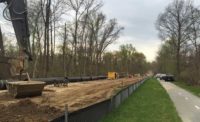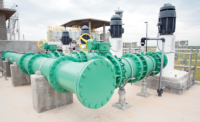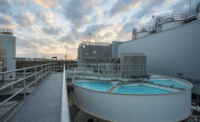Washington, D.C.
Key Players
Owner DC Water
Owner's Representative O’Brien & Gere
Lead Designer McKissack & McKissack
General Contractor PC Construction Co.
Structural Engineer Delon Hampton & Associates
Specialty Tunneling Bradshaw Construction Corp.
Secant Pile Nicholson Construction Co.
Ground Improvements Moretrench American Corp.
Sitework & Green infrastructure Fort Myer Construction
Electrical Singleton Electric
As part of an emergency program to alleviate chronic neighborhood flooding, a one-acre underground cell at the century-old McMillan Slow Sand Filtration Site was converted into a temporary stormwater storage basin. The new basin is capable of holding 3 million gallons of stormwater during heavy rain events.
After the temporary basin was completed, new construction began on additional related elements of stormwater infrastructure. A 25-ft-deep concrete diversion structure diverts flows from the North Capitol Street stormwater sewer to the storage basin. Water flows through a 48-in.-dia pipe inserted through a hand-mined 60-in.-dia liner-plate tunnel beneath North Capitol Street.
The project also included a 55-ft-deep concrete diversion structure that will route flow to a future combined sewer overflow tunnel. Excavation for that structure was supported by 80 65-ft-deep secant piles and three levels of permanent strut-walker bracing. Installation of the secant piles was complicated by the presence of poor soils and proximity to existing utilities. The sewer lines were not deactivated during construction, so flume bypasses were erected inside the piping. Three depressurization wells and chemical grouting prevented the migration of groundwater into the system.
Along Irving Street NW, the project team installed 14 green infrastructure components, including bioswales, infiltration trenches, rain gardens and interconnected planting beds. These components reduced overall project cost, enhance the quality of the neighborhood streetscape and complement the more conventional stormwater management structures. The system provides residents of the two neighborhoods with improved water quality, better flood control and fewer sewer backups.
Much of the construction took place on extremely small sites and busy city streets, so the project team developed detailed plans to maintain traffic, protect pedestrians and homes and coordinate material deliveries. Restricted work hours mandated significant night and off-hour work shifts. No-parking zones, temporary crosswalks, temporary traffic flagging locations and other public safety measures were established.
The project team coordinated with neighboring property owners and stakeholders to keep them advised of construction updates and the effects of upcoming construction activities.






Post a comment to this article
Report Abusive Comment